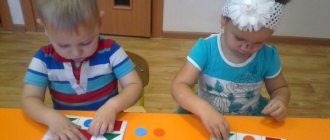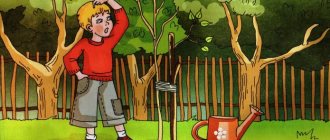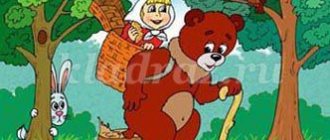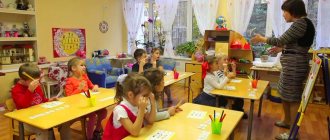Purpose of the lesson
Fix the names of geometric shapes: “triangle”, “square”, “rectangle”, “quadrangle”; learn to classify figures according to different criteria: size, color, shape; practice counting within 10; learn to name a word that is opposite in meaning to the one suggested.
Materials
For the teacher: ball.
For children: a set of geometric shapes of different colors, sizes, shapes (20 pcs.).
Progress of the lesson
Sitting at the table
There are geometric shapes on the tables in front of the children. The teacher asks the children to name them and gives tasks.
Set aside all the circles. What are they in size and color?
Set aside the green pieces. What shape are they? How many are there?
Set aside the quadrangles. Call them differently. Tell me, how many different quadrilaterals are there?
Set aside all the shapes except the triangles. What shape are they?
Set aside the yellow little shapes. What shape are they? Let's play
Games can be played both indoors and on the site.
"Count on"
Children form a circle. The teacher stands in the center of the circle. He's bro-
throws a ball to one of the children and calls any number. The child who catches the ball calls the next 2-3 numbers and returns the ball to the teacher. Now the teacher throws the ball to another child and the game continues.
A variation of the game could be the “Before and After” game. The teacher throws the ball to the child and says: “Count to five.” The child must name the numbers that go up to five: one, two, three, four.
If the teacher says: “After five,” the children must name the numbers: six, seven, eight... The game takes place at a fast pace.
"Vice versa"
The game takes place in a circle. The teacher stands in the center of the circle, throws the ball to one of the children and says the word. The child must say a word that has the opposite meaning. The teacher says: “Forward.” The child answers: “Back.” (Right - left, up - down, far - close, inside - outside, etc.)
Making the game more difficult. You can name not only adverbs, but also adjectives: far - close, upper - lower, right - left, deep - shallow, cheap - expensive, etc.
If the child finds it difficult to answer, the children say the right word in unison.
On a walk
Draw children's attention to the changes that occur in nature in autumn. Find out what time of year and month it is. Ask what month September is (ninth), ask the children to name all the months.
Remind us of the proverbs about autumn.
tt In September there is one berry, and even that bitter rowan.
te September is cold, but full.
tit In September, summer ends and autumn begins.
Tips for a teacher
Don’t forget to tear off a piece of the calendar for the past day every morning with your children. Ask your children what day of the week it was yesterday and what day it is today. Invite the children to name today's date and month. Think back to the summer months.
At the beginning of the school year, it is necessary to conduct an individual interview with each child within two weeks. The purpose of the interview is to identify children’s knowledge, skills and abilities in mathematics. Enter the results of the interview in the table. The contents of the interview and the methodology are given at the end of the book.
Tell parents that over the next two weeks, conversations will be held with children that will reveal their mathematical understanding and ability to operate with them.
Math games with geometric shapes for children 5-7 years old
Games with geometric material to recreate silhouette figures for children of senior preschool age
Author: Nadezhda Vladimirovna Ryabichenko, primary school teacher at the Mikhailovskaya Secondary School, Kikvidzensky district, Volgograd region Brief description: This game can be used in working with children 5-7 years old. To play, you need to take a square, making it from cardboard, plastic or other materials, and cut it along the lines into different shapes. There will be 11 shapes in total: two squares, four triangles, one large quadrilateral and four small quadrilaterals. When composing silhouette figures, all parts are used that are attached to one another, but do not overlap each other. It is possible to use this game with children 3-4 years old, using samples of already composed silhouette figures. Goal: developing the ability to create silhouette figures from polygons. Objectives: - consolidate children’s knowledge about geometric figures; - develop cognitive interest, independence, intelligence, observation, logical thinking, the ability to creatively search, the ability to find new ways to solve a given problem. I offer a square template, which you can increase or decrease if you wish. It doesn’t have to be the same size as mine (that’s why I don’t indicate the dimensions of the square itself).
First, you can look at the square with your children and find out what figures it consists of by asking riddles: Look at this figure: It has only three angles. You are probably ready to name it by the number of angles. (triangle)
I have three sides, I have three angles.
You will quickly call me, I know this. After all, every schoolchild knows, Me - I... (triangle)
I am a figure - no matter where, I am always very even, All angles in me are equal And four sides.
The cube is my beloved brother, Because I... (square)
Not a triangle or a circle, And I’m not a friend to the oval.
I am the brother of the rectangle, After all, my name is... (square)
I have four corners, like a square, But I don’t dare call myself a square, And yet, it looks like a square, by the way, Two long sides, two shorter.
(quadrangle)
We stretched the square and presented it to the eye, Who did it look like Or something very similar?
Not a brick, not a triangle - Became a square... (quadrangle)
Examples of composing figures:
Cow
Giraffe
Envelope
Dog
Tower
I made the game using the DragAndDrop template.
This macro was created by programmer Hans Hofmann (Germany). Working with the DragAndDrop template. 1. Open the program. 2. Click Slide Show
, select
From Beginning
or
From Current Slide
.
3. In the Security Alert
select
Enable this content
, then click
OK
.
4. When creating silhouette figures on a slide, you need to left-click on any figure once , move it to the desired location, and left-click again. We move all the figures in the same way. If a child has difficulty completing a task on his own, he can use a hint. When you click on the word hint, a picture with an image appears in the upper left corner of the slide. When you click on any shape, the hint picture closes. The hint can be used an unlimited number of times.
To create the next silhouette you need to go to the next slide. After completing the task, you can save your work, but it’s better to click “don’t save.” The games can be used by elementary school teachers at extracurricular mathematics events with students in grades 1 and 2, as well as by kindergarten teachers during classes with preschoolers. Parents can use this development to organize their children’s leisure time.
Presentation on the topic: Mathematical games with geometric shapes
We recommend watching:
Mathematical games with Cuisenaire sticks for children 6-7 years old Mathematical fairy tale - a game for children of the preparatory group of preschool educational institutions Didactic games in mathematics for children 4-6 years old Mathematical game in kindergarten for preschoolers with learning difficulties
Similar articles:
Exercises with counting sticks for preschoolers
Math problems jokes for preschoolers
Mathematical riddles for preschoolers in verse with answers
Games for the development of elementary mathematical concepts in preschoolers 3-5 years old
Games with geometric shapes for children 4-6 years old
Learning geometric shapes with kids in preschool educational institutions
When studying geometric concepts, children also gain other knowledge and skills in parallel:
- they learn to think logically;
- get the opportunity to develop knowledge of the Russian language;
- the perception of space and the ability to navigate in it improves;
- children develop fine motor skills;
- Intellectual qualities develop: the ability to make comparisons, analyze, and generalize.
Note! When teaching in kindergarten, the development of geometric concepts is not highlighted as a separate topic, but occurs in combination with other topics.
Children learn geometry
Learning colors and shapes for children from 2 years old
Geometry learning should begin with the simplest figures; more complex ones should be left for subsequent years. It is believed that children are able to perceive shape on a subconscious level within six months after birth. At this time, the main way of teaching is through mention during the story. When showing pictures, you can casually notice that the objects depicted have a certain shape.
When teaching, you need to take into account that kids can only learn to distinguish between the simplest ones: circle, square and triangle.
Note! Studying in a year or two or three should be easy and fun. For mastering it is convenient to use three-dimensional figures. Studying, for example, a circle, you can imagine that he came to visit the baby. You can use your child's finger to trace a circle along the outline. You can make such an applique, decorating it with eyes and a nose.
Experimental activities in the middle group
A child can play with this item: make a tower by placing one on top of the other, throw it to the side or put it in a box.
This integrated approach to a geometric design project is very effective for toddlers, but for younger children it can be considered the primary way to learn shapes.
For children under two years of age, the following may be used:
- children's ability to compare objects;
- use a children's educational set, where you need to select a hole of a suitable shape and size for the figurine.
A two-year-old child is able to choose the appropriate shape from a set.
When they teach figures to 3-year-old children, they can already show the one that was named by the teacher.
Learning figures for children 3 years old
When teaching children geometric shapes, it is important to consolidate familiarity with the material that they have previously learned. We need to continue studying and move on to those that are more difficult to understand - oval, rhombus and rectangle.
When teaching children, you can show children examples of figures, letters of the alphabet and compare them with other objects in shape and size.
Important! During the walk, children are told about the objects they see, mentioning their shape and simple geometric properties.
An important role when teaching geometric shapes to children is played by creative activities, when children draw or sculpt samples and put them together from a given set of component parts.
Using cards depicting complex objects, the child is asked to talk about the components in the form of certain shapes.
Children education poster
Geometric shapes in the senior group
At this time, the lessons move on to considering new, more difficult to understand figures, repeating those that they should have known before.
In classes at the age of five, children are asked to consider and talk about their common and different properties. For example, questions are asked about where open figures have corners and in which cases they do not.
They try to teach children to analyze the complex shapes of real objects, to find elements in them that have the form of simple figures. They learn about more complex shapes, such as a cone.
Geometric shapes in the preparatory group
At this age, children have already mastered the basics of understanding the shapes of objects. At this stage, it is important to develop knowledge and make it more systematic. At this age, children develop a foundation for schooling.
Note! Children in the preparatory group, when introduced to polygons, are told about their sides and angles, and are taught to find the desired figure using a description.
Here is an example of an educational game that can be included in a lesson note and used for teaching. Children are given a set of figures. The player places one of them. Another should put next to it one that differs in only one attribute. For example, if one offers a large blue square, then the other may lay out a small blue square, a large yellow square, or a large blue circle.
The teacher tells the children about the figures





